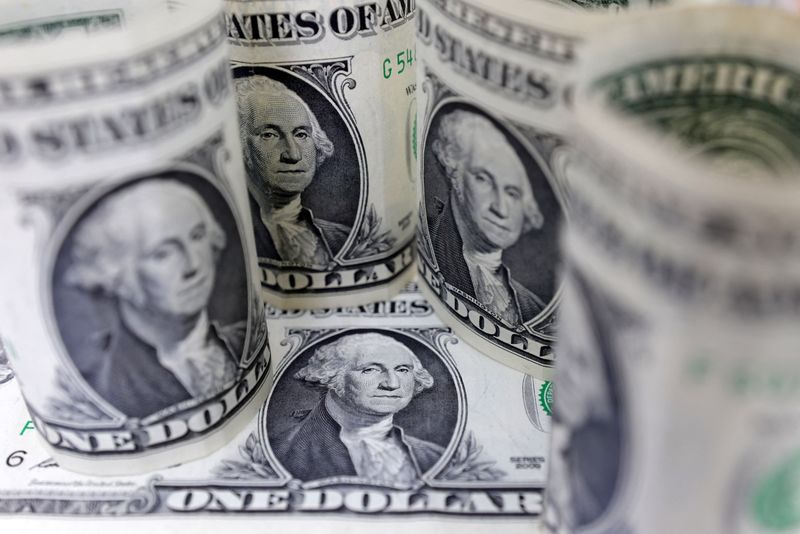Forex
Dollar ticks up ahead of busy data week; yen under pressure


© Reuters. FILE PHOTO: U.S. Dollar banknotes are seen in this illustration taken July 17, 2022. REUTERS/Dado Ruvic/Illustration/File Photo
By Karen Brettell and Alun John
NEW YORK (Reuters) – The U.S. dollar fell on Tuesday, reversing earlier gains, after data showed that U.S. job openings fell in July, before this week’s highly anticipated jobs report for August.
Job openings, a measure of labor demand dropped 338,000 to 8.827 million on the last day of July, the lowest level since March 2021.
The data is “a very soft look at labor demand as outright job openings continue to slide in response to the increasingly evident lagged impact of higher policy rates,” Ben Jeffery, an interest rate strategist at BMO Capital Markets said in a note.
Against a basket of currencies, the dollar was last down 0.11% at 103.82. It is holding below the 104.44 level reached on Friday, which was the highest since June 1.
U.S. economic resilience has raised concern that the Federal Reserve could make further rate increases in an effort to bring inflation back down closer to its 2% annual target.
U.S. personal consumption expenditures on Thursday and the August jobs reports on Friday are in focus this week for further clues on the direction and strength of the U.S. economy.
Other data on Tuesday showed that U.S. consumer confidence was below economists’ expectations, and U.S. home prices rose on a monthly basis in June, while annual prices were unchanged.
Federal Reserve Chair Jerome Powell said on Friday that further rate increases may be needed to cool still-too-high inflation, but also promised to move with care at upcoming meetings.
Markets are pricing in an 85% chance of the Fed standing pat on interest rates next month, according to the CME Group’s (NASDAQ:) FedWatch Tool, but the odds of a hike by the November meeting are now at around 56% compared with 46% a week earlier.
The dollar briefly reached an almost 10-month high against the Japanese yen earlier on Tuesday as investors priced in the likelihood of a more hawkish Fed.
The Bank of Japan remains an outlier among global central banks with its loose monetary policy, even as it slowly shifts away from yield curve control.
“It is moving away from excessively loose monetary policy, but it’s doing so at a very slow and measured pace,” said Bipan Rai, North American head of FX strategy at CIBC Capital Markets in Toronto. “It’s still punitive to be short dollar/yen.”
The dollar hit 147.375 yen on Tuesday, the highest since Nov. 7, and was last at 146.365, down 0.12% on the day.
Traders are watching for any signs of intervention by Japanese officials to shore up the ailing currency. Japan intervened in currency markets last September when the dollar rose past 145 yen, prompting the Ministry of Finance to buy the yen and push the pair back to around 140 yen.
Charu Chanana, market strategist at Saxo, said that the intervention threat has retreated at sub-150 levels, given a lack of currency-related comments from Bank of Japan Governor Kazuo Ueda at the Jackson Hole conference and no signs of verbal intervention yet.
Concerns about China’s weakening economy have also boosted the greenback in recent weeks, even as the yuan is being buoyed by the Chinese central bank’s month-long effort to set the daily fixing at stronger-than-expected levels.
“It does feel like we’re heading toward the risk of a liquidity trap in China and that risk premium is being priced into the yuan and that’s helping boost the dollar via safe haven and liquidity demand,” said Rai.
Eurozone inflation data due on Thursday may be key to whether or not the European Central Bank hikes rates at its September meeting, which in turn could set the near-term tone for the euro.
“We have the euro zone CPI report Thursday which the market is putting a great deal of weight on with the ECB’s decision in September seen as finely balanced,” said Lee Hardman, senior currency analyst at MUFG.
The euro was last up 0.20% at $1.0840. It fell to $1.07655 on Friday, the lowest since June 13.
========================================================
Currency bid prices at 10:35AM (1435 GMT)
Description RIC Last U.S. Close Pct Change YTD Pct High Bid Low Bid
Previous Change
Session
Dollar index 103.8200 103.9400 -0.11% 0.319% +104.3600 +103.7500
Euro/Dollar $1.0840 $1.0819 +0.20% +1.17% +$1.0851 +$1.0782
Dollar/Yen 146.3650 146.5350 -0.12% +11.64% +147.3700 +146.1750
Euro/Yen 158.67 158.51 +0.10% +13.09% +159.0500 +158.2500
Dollar/Swiss 0.8810 0.8840 -0.35% -4.73% +0.8858 +0.8805
Sterling/Dollar $1.2609 $1.2599 +0.10% +4.28% +$1.2635 +$1.2563
Dollar/Canadian 1.3598 1.3599 +0.00% +0.37% +1.3637 +1.3588
Aussie/Dollar $0.6450 $0.6430 +0.35% -5.35% +$0.6457 +$0.6401
Euro/Swiss 0.9548 0.9559 -0.12% -3.51% +0.9568 +0.9550
Euro/Sterling 0.8595 0.8583 +0.14% -2.82% +0.8597 +0.8566
NZ $0.5940 $0.5910 +0.57% -6.40% +$0.5945 +$0.5888
Dollar/Dollar
Dollar/Norway 10.6650 10.7160 -0.46% +8.69% +10.7390 +10.6650
Euro/Norway 11.5649 11.5932 -0.24% +10.21% +11.6070 +11.5498
Dollar/Sweden 10.9340 10.9780 -0.20% +5.06% +11.0261 +10.9211
Euro/Sweden 11.8535 11.8778 -0.20% +6.31% +11.9014 +11.8432

 Forex3 years ago
Forex3 years agoForex Today: the dollar is gaining strength amid gloomy sentiment at the start of the Fed’s week

 Forex3 years ago
Forex3 years agoUnbiased review of Pocket Option broker

 Forex3 years ago
Forex3 years agoDollar to pound sterling exchange rate today: Pound plummeted to its lowest since 1985

 Forex3 years ago
Forex3 years agoHow is the Australian dollar doing today?

 Cryptocurrency3 years ago
Cryptocurrency3 years agoWhat happened in the crypto market – current events today

 World3 years ago
World3 years agoWhy are modern video games an art form?

 Commodities3 years ago
Commodities3 years agoCopper continues to fall in price on expectations of lower demand in China

 Economy3 years ago
Economy3 years agoCrude oil tankers double in price due to EU anti-Russian sanctions





















